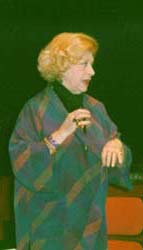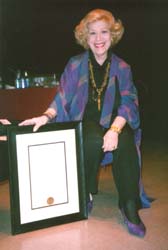| Encounters with a MASTER TEACHER... |
The REGINA RESNIK Pages
Master Classes:
at Danny Kaye
in San Diego
A Kurt Weill Celebration
Rossini at Danny Kaye
Carmen in Omaha
Recital CD
Discography
Met Ring '97: Side Shows
Store
MusicPlanner
New Releases
Audience Etiquette
AudioFiles
The Press Room
about FanFaire
Site Map
Sign up for:
Email Updates
Steven H. and Alida Brill Scheuer Foundation / UCSD Extended Studies and Public Programs)
 |
This
time around, she came to San Diego as the first honoree and guest
lecturer of the series Visions and Voices: In Celebration of Women
(the others were writer-speaker-pediatrician-activist Helen Caldicott
and film director Joan Micklin Silver). Ms. Resnik's "lectures"
took the form of master classes: two 3-hour sessions with two sets
of students, conducted over two afternoons. Ms. Resnik preferred to
call the sessions encounters with a master teacher, explaining that
time constraints did not allow for the breadth and depth of coverage
of the traditional master class. The first group of students were made up of the young professional singers of the San Diego Opera Ensemble who bring live opera productions to schools and other locations in San Diego county. Students from the University of California and the San Diego State University comprised the second group. It did not matter that one was a professional or a student, Ms. Resnik gave each singer the same undivided attention. Each singer had about 40 minutes to sing an aria and be critiqued by the master teacher. And what an education each 40-minute segment was - presumably for the singer and most certainly for the audience - as if a chapter of a great book on the art of singing came alive before one's eyes (and ears)! |
It was a lesson in the mechanics, if not the anatomy, of breath and the human voice. Ms. Resnik instantly recognized a good voice, and suggested ways to make it more beautiful. Pointing to the area between the abdomen and the neck, she repeatedly stressed that the voice must originate not from the throat but from deeper within the body. Cognizant of individual idiosyncrasies, she would ask one singer to relax or stand a certain way making sure the spine is straight, another to sing with arms akimbo, and yet another to smile while singing a certain line - whatever it took to bring out a fuller, more polished sound. And like magic, her prescriptions worked without exception - one could tell the difference between "before" and "after." Again, in the process we learned that voice projection is all about breath and diaphragm control - over the volume and passage of air from the cavity within up through the organ of voice.
And of course, when all discussions of rhythm and tempi and melody, of fortissimo and pianissimo, of phrasing and stylistic embellishments, of legato and portamento and staccato are taken into account - the sessions added up to one big lesson in music given by a true master teacher who amazed everyone - with the acuity of her mind, the sharpness of her wit and fantastic sense of humor, the breadth of her knowledge (she knew from memory the words to every aria whether soprano or mezzo or tenor or baritone - a dozen altogether - and every marking on the score!), and the impassioned devotion to her art that moves her to pass this knowledge to today's generation of singers. (Here's a quick paraphrase of some of her words of wisdom:
| Look
at the poetry, at how the words are written, and know what the composer
is asking you to do; and when you have the role in your voice, then
think how to act.... Be technically sure of what you want to do with your sound.... e.g., Mozart's Queen of the Night aria is for the dramatic voice and not for a young voice or a coloratura.... Don't forget that everyone in the audience is paying to get every note! The voice is like a string of pearls... as a singer you should spend your life making each pearl creamy - that's what studying is all about, making the most beautiful sound you can make. |
The 2-day encounter with the master teacher was capped with the presentation of a gift of appreciation and an award in her honor which read as follows:
Visions and Voices Steven H. and Alida Brill Scheuer Foundation and University of California, San Diego Extended Studies & Public Programs Honors Regina Resnik Visions and Voices seeks to highlight women whose artistic and intellectual contributions have transformed the map of twentieth century creative life. With our first participant, we celebrate the life and work of Regina Resnik. |
 |
| Regina
Resnik's stellar operatic career - beginning with her dramatic debut
in 1942, soaring with her defining role of Carmen in the mid-1950's,
and continuing with her countless interpretations of traditional and
contemporary roles through the 1990's - truly places her in opera's
pantheon. Her rare gift has been to combine this great talent with
enormous generosity in her devotion to her teaching career. Through
her teaching and directing, she inspires the next generation of singers
and musicians, as both mentor and model. Therefore, we, today, at this Master Class on November 7, 2024 proudly inaugurate the Visions and Voices program with Regina Resnik, who has given so much of herself to all of those who love opera. Regina, it is the breadth of your vision and the spirit of your voice that give us the great privilege of bestowing this honor upon you. Mary Lindenstein Walshok, Associate Vice Chancellor University of California, San Diego, Extended Studies and Public Programs Alida Brill Scheuer, The Steven H. and Alida Brill Scheuer Foundation |
|
-GC/FanFaire'98